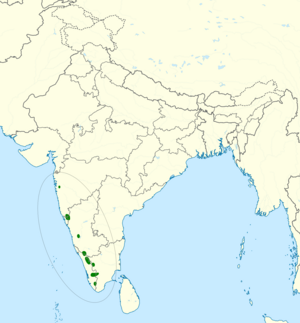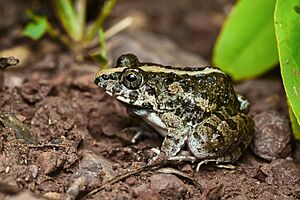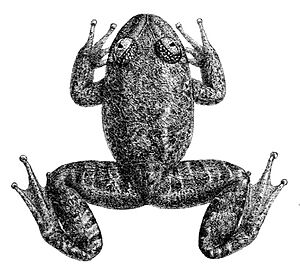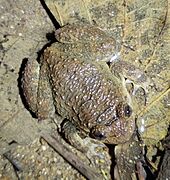Malabar night frog facts for kids
Quick facts for kids Malabar night frog |
|
|---|---|
 |
|
| Conservation status | |
| Scientific classification | |
 |
|
| Range of N. major; reports of the species from Maharashtra are probably erroneous | |
| Synonyms | |
|
The Malabar night frog, also known as the large wrinkled frog, is a type of frog. Its scientific name is Nyctibatrachus major. It belongs to a group of frogs called Nyctibatrachidae, often known as "robust frogs."
This frog was first described in 1882 by a scientist named George Albert Boulenger. It's a fairly large frog for its kind. Males grow to about 3.1 to 5.2 centimeters (1.2 to 2.0 inches) long. Females are a bit larger, reaching 4.3 to 5.4 centimeters (1.7 to 2.1 inches).
The Malabar night frog is mostly brownish or greyish. It has a dark grey-brown back and a grey-white belly. Its sides are light grey. You might also see different grey or brown patterns on its skin.
This frog lives only in the Western Ghats mountains of India. It can be found in the states of Kerala, Tamil Nadu, and Karnataka. Adult frogs live in fast-moving streams in forests. They need very specific places to live.
Adults are mostly active at night and stay near water. Younger frogs can be seen during the day too. The Malabar night frog eats other frogs and insect larvae. Females lay small groups of eggs on leaves or rocks above the water. When the eggs hatch, the tiny tadpoles drop into the stream below.
Sadly, the Malabar night frog is considered a vulnerable species. This means its numbers are decreasing. Its home is getting smaller and broken up. Pollution and human activities also threaten it.
Contents
Taxonomy and Classification
The Malabar night frog was officially named Nyctibatrachus major in 1882. This was done by the zoologist George Albert Boulenger. He also created the group, or genus, called Nyctibatrachus at the same time.
Later, in 1910, another scientist named Nelson Annandale described a frog called Rana travancorica. He thought it was a different species. However, in 1978, a scientist named Raghavan Pillai found that Rana travancorica was actually the same as N. major. So, it became a synonym.
Today, N. major is one of 34 species in the Nyctibatrachus genus. This group of frogs is part of the Nyctibatrachidae family. Scientists use DNA barcoding to identify these frogs. This helps them learn more about the species and how to protect it.
Scientists study the relationships between different frog species. They use special diagrams called cladograms to show how species are related. For example, the Malabar night frog is closely related to species like N. acanthodermis and N. gavi.
|
|||||||||||||||||||||||||||||||||||||||||||
Description
The Malabar night frog is a large frog for its genus. Males are about 3.1 to 5.2 centimeters long. Females are slightly larger, from 4.3 to 5.4 centimeters long.
Its back is dark grey-brown with lighter grey and dark brown patterns. Its belly is grey-white. The area around its eyes and ears is dark brown. There is also a dark grey stripe between its eyelids. Its eyes have dark brown irises.
The sides of its belly are light grey with white and dark grey spots. Its legs are brown with pale diagonal stripes. When preserved in alcohol, the frog's colors change to grey-brown and whitish.
Males and females look similar. However, males have special glands near their inner thighs. These are called femoral glands. Like other frogs in its genus, it has two rows of small teeth on its upper jaw. It also has a bluish-black liver that can be seen through its skin. Male frogs have two vocal sacs that help them make calls. These sacs expand when inflated.
It can be hard to tell this frog apart from other Nyctibatrachus species. But its large size helps. It also has well-developed finger and toe pads. Its skin is noticeably wrinkled and bumpy. It has medium-sized webbing between its fingers. A Y-shaped ridge from its upper lip to its nostrils is also a key feature.
Tadpoles
Malabar night frog tadpoles are mostly black. Their bodies are brown, and the underside of their heads is also brown. Their tails are mostly white. They have two long pale marks on their lower backs. The tail has dark bands near the front.
Tadpoles can grow up to 5.2 centimeters (2.0 inches) long. About half to two-thirds of their length is their tail. Their heads and bodies are somewhat egg-shaped and flat. Their mouths are small and have no teeth.
When tadpoles reach about 1.5 to 1.9 centimeters (0.6 to 0.7 inches) long, they start to change into froglets. This process is called metamorphosis. At this stage, they only have a small tail stump.
Vocalizations
Male Malabar night frogs make calls to attract mates. These calls are single notes, about 0.05 seconds long. They usually call about every 20 seconds. The calls are mostly in a sound range of 0.6 to 1.9 kHz. Sometimes, they make calls at a higher frequency, around 2.43 kHz.
Habitat and Distribution
The Malabar night frog lives only in the Western Ghats of southern India. You can find it in the states of Kerala, Tamil Nadu, and Karnataka. Earlier, people thought it also lived in Maharashtra, but those reports were likely wrong.
Adult frogs live in fast-moving streams. These streams are found in evergreen forests, deciduous forests, and re-grown forests. They can be found at elevations from sea level up to 900 meters (2,950 feet).
These frogs prefer forests that are not disturbed by humans. They usually avoid areas where the habitat is damaged or open spaces near forest edges. The streams they live in are slightly acidic, with low temperatures. They also have low light and lots of dissolved oxygen.
Tadpoles also need very specific conditions. They prefer streams with cool air and water. They need low light and thick tree cover. High humidity and lots of leaf litter (fallen leaves) are also important. Tadpoles have been found at elevations up to 825 meters (2,700 feet).
Ecology
Adult Malabar night frogs are mostly active at night. They spend most of their time in the water. You can often see them on rocks near streams. During the day, adults usually hide under rocks. However, younger frogs are more active during the day.
If they feel threatened, they will quickly move through the mud at the bottom of the stream. They stay underwater for a while before coming back to the surface. Some people have seen them rarely bury themselves in mud or try to hide in plants near the water.
Diet

The Malabar night frog mainly eats insect larvae and other frogs. It eats insects like dragonflies, beetles, true bugs, and springtails.
It also eats other frog species. These include Fejervarya limnocharis, Euphlyctis cyanophlyctis, and Micrixalus saxicola. It eats F. limnocharis and E. cyanophlyctis often. This might be because these frogs live in the same watery places.
Reproduction and Life Cycle
Scientists don't know much about the Malabar night frog's life cycle and how it breeds. Females with mature eggs have been found from May to June. Tadpoles have been collected in October.
Males have femoral glands that seem to change slightly with the seasons. They are longer from February to September, which is before and during the monsoon season. This suggests these glands might be important for reproduction.
Mature eggs are colored and about 4.1 millimeters (0.16 inches) wide. Younger eggs are smaller and clear. Females have eggs at different stages of development at the same time. This means they lay several small groups of eggs over days or weeks. They don't lay one big group all at once.
Eggs are laid on leaves and rocks that hang over the water. The male frogs guard the eggs until they hatch. When the eggs hatch, the tadpoles fall into the water below. Tadpoles change into small froglets in about 98 days.
Conservation
The Malabar night frog is listed as a vulnerable species on the IUCN Red List. This is because its living areas are small and broken up. Its habitat is also being damaged.
Many things threaten this frog's home. These include deforestation (cutting down forests) and harvesting wood. Land is also being changed for farming. Building check dams and roads also harms their habitat. More tourism in their area is also a problem.
Adult frogs and tadpoles are very sensitive to changes in their environment. So, more human activities that change their habitat can lead to fewer frogs. This has happened with a related frog, N. aliciae.
The frog may also be threatened by nitrate pollution. This pollution comes from using too much fertilizer. Many streams where the frog lives are next to farms. These farms use a lot of nitrogen-based fertilizers. This leads to high levels of nitrates in the water.
Even small amounts of nitrates can harm the tadpoles. They can cause problems like paralysis, restlessness, and strange swimming. Their body parts can also swell. Protecting their forest streams is very important for the Malabar night frog's future.





